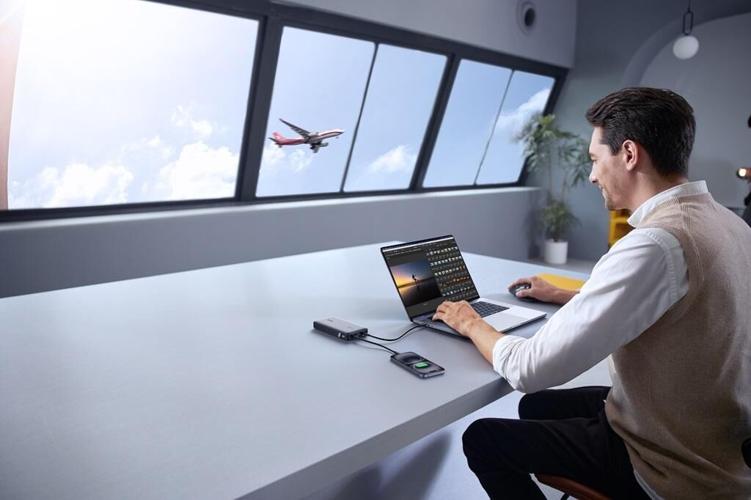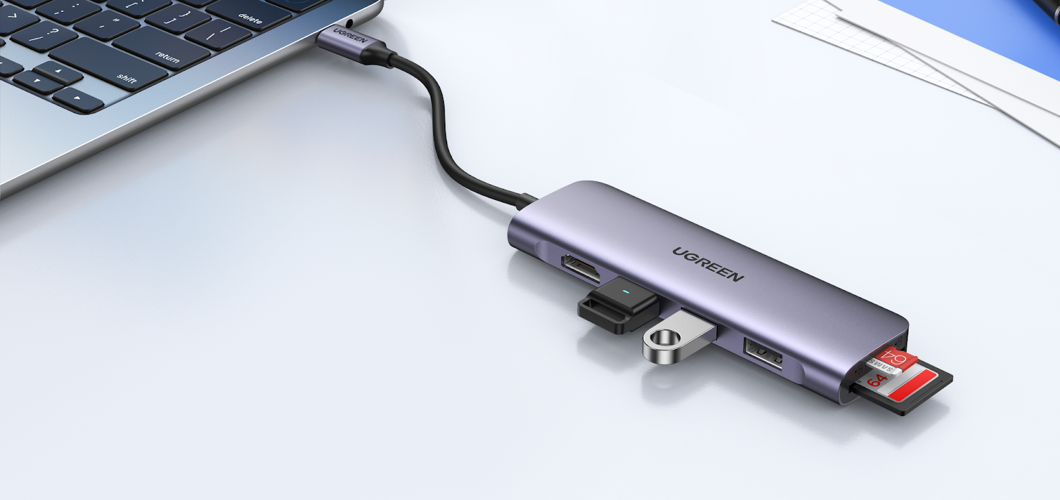As a digital nomad, you’re always on the move—working from beachside cafes, co-working spaces, and remote villages. Yet no matter where you find yourself, keeping your devices powered up is non-negotiable. That’s why a multi-port docking station and a travel wireless power bank have become essential tools for mobile productivity. A multi-port docking station can transform your laptop into a fully functional desktop setup in seconds, while a travel wireless power bank ensures your phone, tablet, and other gadgets stay charged without hunting for power outlets. In this article, we’ll explore how to assemble a lightweight yet powerful kit to maximize efficiency on the road.

Core Needs of a Digital Nomad
For digital nomads, juggling multiple electronic devices is part of daily life. Your typical “office” might include:
A laptop for heavy-duty work and content creation
A smartphone for quick communication and hotspot usage
A tablet or e-reader for reading and light editing
Wireless earbuds or headphones for noise-cancelled video calls
A digital camera or action cam to capture content on the go
A smartwatch for notifications and fitness tracking
These devices all demand reliable power and seamless connectivity. Without a stable internet connection or a power socket nearby, productivity grinds to a halt. Furthermore, hotels and cafes often lack sufficient outlets, and public USB ports can be slow or insecure. To overcome these challenges, you need a multi-port docking station that serves as a central hub for connecting monitors, keyboards, mice, and Ethernet—turning any table into a productive workspace—and a travel wireless power bank to keep your smaller gadgets charged wirelessly or via USB-C.
Beyond charging and connectivity, digital nomads also value portability, lightweight gear, and easy setup. All accessories should be compact enough to fit in a backpack without adding bulk, yet durable enough to withstand constant travel. In the following sections, we’ll delve deeper into the essential tools that meet these criteria.
The Multi-Port Docking Station: Centralizing Connectivity
A multi-port docking station is arguably the single most transformative accessory for a digital nomad. It functions as a one-stop hub, allowing you to connect multiple peripherals to your laptop via a single cable—typically USB-C or Thunderbolt 3/4. Here’s why you need one:
1. Expand Your Screen Real Estate
Many digital nomads work with multiple windows open—email, spreadsheets, design apps, or coding environments. A docking station with one or two HDMI or DisplayPort outputs supports dual monitors, boosting productivity by allowing you to multitask more effectively.
2. Consolidate All Peripherals
Instead of carrying separate adapters—HDMI, VGA, Ethernet, USB-A to USB-C—you plug your laptop into the docking station and let it handle the rest. Look for a unit that includes:
USB-A ports (for older peripherals like external hard drives)
USB-C ports (for fast data transfer and charging)
HDMI/DisplayPort (for external monitors)
Ethernet (RJ45) (for faster, more reliable internet when Wi-Fi is weak)
SD/TF card slots (for photographers or travel bloggers)
3. Power Delivery for Laptops
Many docking stations support Power Delivery (PD) at 60W to 100W, meaning the same hub that connects your monitor and keyboard can charge your laptop. This eliminates the need to carry a separate laptop charger—just the docking station’s power adapter.
4. Portability & Build Quality
Modern multi-port docking stations are designed with portability in mind. Look for slim, aluminum-bodied models that weigh under 200g. Some even feature built-in retractable cables or foldable designs, making them ideal for slipping into a travel backpack.
5. Use Cases
Co-working Spaces or Cafes: Quickly set up dual monitors and wired internet for seamless video calls and heavy downloads.
Hotel Rooms: Convert your nightstand or small desk into a high-efficiency workstation.
Client Presentations: Plug in your laptop to their projector via HDMI, while printing documents through USB-A simultaneously.
By investing in a reliable multi-port docking station, you minimize cable clutter, reduce setup time, and gain a desktop-like experience anywhere you go.

The Travel Wireless Power Bank: Freedom from Outlets
A typical day for a digital nomad might involve hopping from coffee shop to coffee shop, or exploring a new city during breaks. In such unpredictable scenarios, having a travel wireless power bank can be a game-changer. Here’s why:
1. Dual Charging Modes
A travel wireless power bank often supports both wireless Qi charging (10W–15W) and wired fast charging (USB-C PD at 18W–45W). Wireless Qi allows quick “set-and-forget” power-ups for your phone or wireless earbuds, while the wired USB-C PD port can rapidly charge more power-hungry devices like tablets or laptops (for smaller notebooks).
2. Sufficient Capacity without the Bulk
While bulky power bricks can weigh down your bag, a well-designed travel wireless power bank packs a 10,000mAh to 20,000mAh battery into a slender, pocket-friendly form. This capacity is enough for 2–3 full smartphone charges, or a partial laptop boost when you’re unable to find an outlet.
3. Convenience in Motion
On-the-Go Wireless Charging: During long commutes on trains or buses, set your Qi-enabled phone on top of the power bank. No need to fuss over tangling cables.
Desk Companion: When you’re working at a café or co-working space, place the travel wireless power bank beside your laptop. It wirelessly charges your phone while your laptop remains connected to the docking station.
Emergency Backup: If your main backpack stash of chargers is inaccessible, a travel wireless power bank in your daypack ensures you never face a dead battery.
4. Key Features to Consider
Input & Output Speed: Ensure the unit supports USB-C PD input/output—some models can deliver 45W or even 60W, enough to charge many ultrabooks.
Multiple Outputs: Look for at least one USB-C PD port and one USB-A Quick Charge port.
Safety Protections: Overcharge, overheat, and short-circuit protection keep both the power bank and your devices safe.
Indicator LEDs: Clear readouts of remaining power let you know when to top up the bank itself.
With a travel wireless power bank in your kit, you’ll never have to hunt for a vacant outlet or carry a tangled bundle of cables again.

Additional Must-Have Accessories for Any Digital Nomad
Beyond a multi-port docking station and a travel wireless power bank, several other tools can significantly enhance your productivity and convenience on the road. Below are essential add-ons that cater to the nuanced needs of traveling pros:
1. Portable Foldable Laptop Stand
A sturdy yet lightweight laptop stand raises your screen to eye level, reducing neck strain and improving posture. Many models fold flat into your bag, and some even double as wireless laptop coolers with built-in ventilation. When paired with a multi-port docking station, your elevated laptop creates a desktop-grade workstation wherever you sit.
2. Noise-Cancelling Wireless Headphones or Earbuds
Working from noisy cafes, co-working spaces, airports, or public transport can be challenging. Active noise-cancelling (ANC) headphones or true wireless earbuds help you focus by blocking background chatter. Look for models with long battery life (8–10 hours on a single charge) and quick charge features—just 10–15 minutes of charging yields several hours of playback.
3. All-in-One Multi-connector Charging Cable
Managing multiple cables for various devices (USB-C, Lightning, Micro-USB) is inefficient. Instead, invest in a three-in-one braided cable featuring USB-C, Lightning, and Micro-USB connectors. A single cable becomes your universal charging and data-transfer lifeline, fitting neatly into your keychain or laptop sleeve.
4. Compact USB-C Hub with Built-In SD/TF Slot
If a full-sized docking station feels too bulky for quick trips, a smaller USB-C hub—featuring 2–3 USB-A ports, 1 HDMI port, and SD/TF card readers—might be enough. These hubs are typically pocket-sized and can fit in your jeans or jacket pocket. They let you plug in a flash drive or microSD card for offloading videos and photos on the go.
5. Mobile Wi-Fi Hotspot (MiFi) Device
Even with a power bank or docking station, you still need a reliable internet connection. A portable MiFi device that accepts a local SIM card ensures you have fast data anywhere—often supporting 4G LTE or even 5G. Some MiFi devices let multiple devices connect simultaneously, making it easy to share secure internet with a team.
6. Smart Luggage or Backpack with Built-In USB Ports
Smart backpacks with integrated USB-A or USB-C ports allow you to charge your phone by simply plugging it into the bag’s external port. These backpacks usually include a hidden internal pocket for your power bank and come with RFID-blocking compartments to protect sensitive documents.
7. Compact Waterproof Hard Case for Storage
Electronics and water don’t mix—especially in tropical climates or rainy seasons. A small, hard-shell, waterproof case with customizable foam inserts keeps your most valuable devices—like a GoPro, smartphone, travel wireless power bank, and charging cables—safe from impact and moisture.
8. Wireless Presentation Remote for Virtual Meetings
Conducting virtual presentations or remote teaching sessions can be easier with a small, plug-and-play wireless presenter. These devices often double as laser pointers and can navigate slides from up to 30 feet away, perfect for showing charts or pitching ideas during video calls.
9. USB-C to Ethernet Adapter
Often overlooked, having a quick USB-C to Ethernet adapter can dramatically improve internet stability when working in a business center, co-working space, or hotel lobby. Unreliable Wi-Fi can kill productivity—Ethernet is more reliable for large file uploads, video calls, or streaming.
10. Compact Tripod with Smartphone/Tablet Mount
For digital nomads who create content—travel bloggers, vloggers, or remote educators—having a portable tripod is essential. A lightweight tripod with an adjustable mount can hold a smartphone, tablet, or even a compact mirrorless camera. This accessory is invaluable for shooting stable videos, time-lapses, or group calls without straining your arms.
How These Accessories Work Together
When you assemble your digital nomad kit—starting with a multi-port docking station and a travel wireless power bank—adding the above accessories refines your setup:
Power Continuity: Your travel wireless power bank and multi-port hub ensure all devices remain powered, even when outlets are scarce.
Connectivity: The multi-port docking station and USB-C hub cover all connection needs—monitors, Ethernet, external storage.
Ergonomics & Comfort: The foldable stand and noise-cancelling headphones keep you comfortable and focused during long working sessions.
Content Creation & Presentations: A compact tripod and wireless remote let you produce professional-looking videos or conduct seamless virtual presentations.
Secure Storage & Carrying: A waterproof hard case and smart backpack keep everything organized, protected, and easily accessible.
Reliable Internet: A MiFi device or USB-C to Ethernet adapter ensures that you’re never out of touch with the world.
Travel-Friendly Charging & Connectivity Tips
Tactical Charging: Charge your travel wireless power bank and multi-port hub the night before leaving a location where plugs are available.
Cable Management: Use Velcro straps or cable organizers to bundle multi-headed cables and keep them tangle-free.
Network Backup: Always have a local SIM or roaming plan in your MiFi device as a fallback if Wi-Fi is spotty.
Device Prioritization: In case of limited power, prioritize charging essential devices—laptop first, then phone, then accessories.
Safety Checks: Regularly inspect cables and power banks for wear; replace any frayed or damaged items to prevent failures on the road.
For digital nomads, assembling the right mix of gadgets is critical. A multi-port docking station centralizes connectivity, while a travel wireless power bank guarantees power on the go. Coupled with foldable stands, noise-cancelling headphones, versatile cables, and other handy accessories, you can create a lightweight yet powerful mobile office. Choose devices that support universal fast charging standards, pack smart, and maintain your gear properly—then no matter where you roam, your workflow stays smooth, your battery never drops to zero, and your productivity soars.




(0) comments
We welcome your comments
Log In
Post a comment as Guest
Keep it Clean. Please avoid obscene, vulgar, lewd, racist or sexually-oriented language.
PLEASE TURN OFF YOUR CAPS LOCK.
Don't Threaten. Threats of harming another person will not be tolerated.
Be Truthful. Don't knowingly lie about anyone or anything.
Be Nice. No racism, sexism or any sort of -ism that is degrading to another person.
Be Proactive. Use the 'Report' link on each comment to let us know of abusive posts.
Share with Us. We'd love to hear eyewitness accounts, the history behind an article.